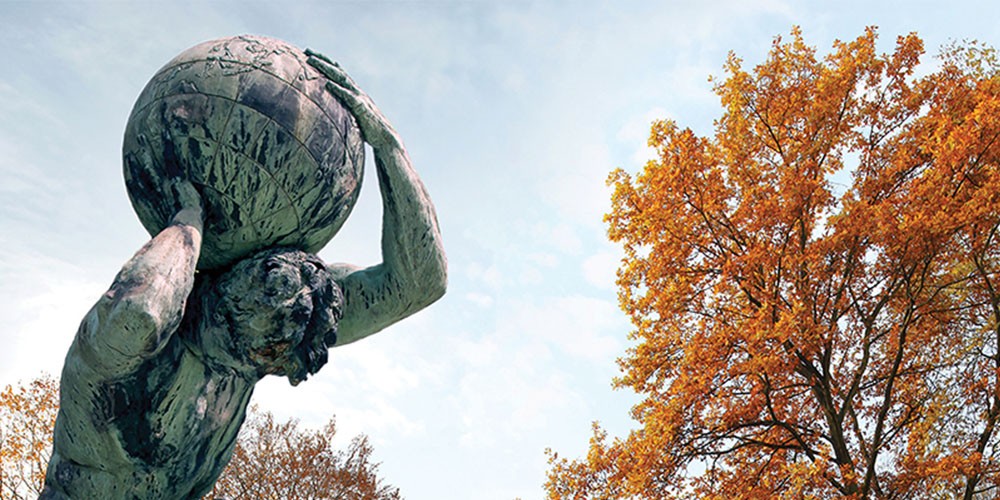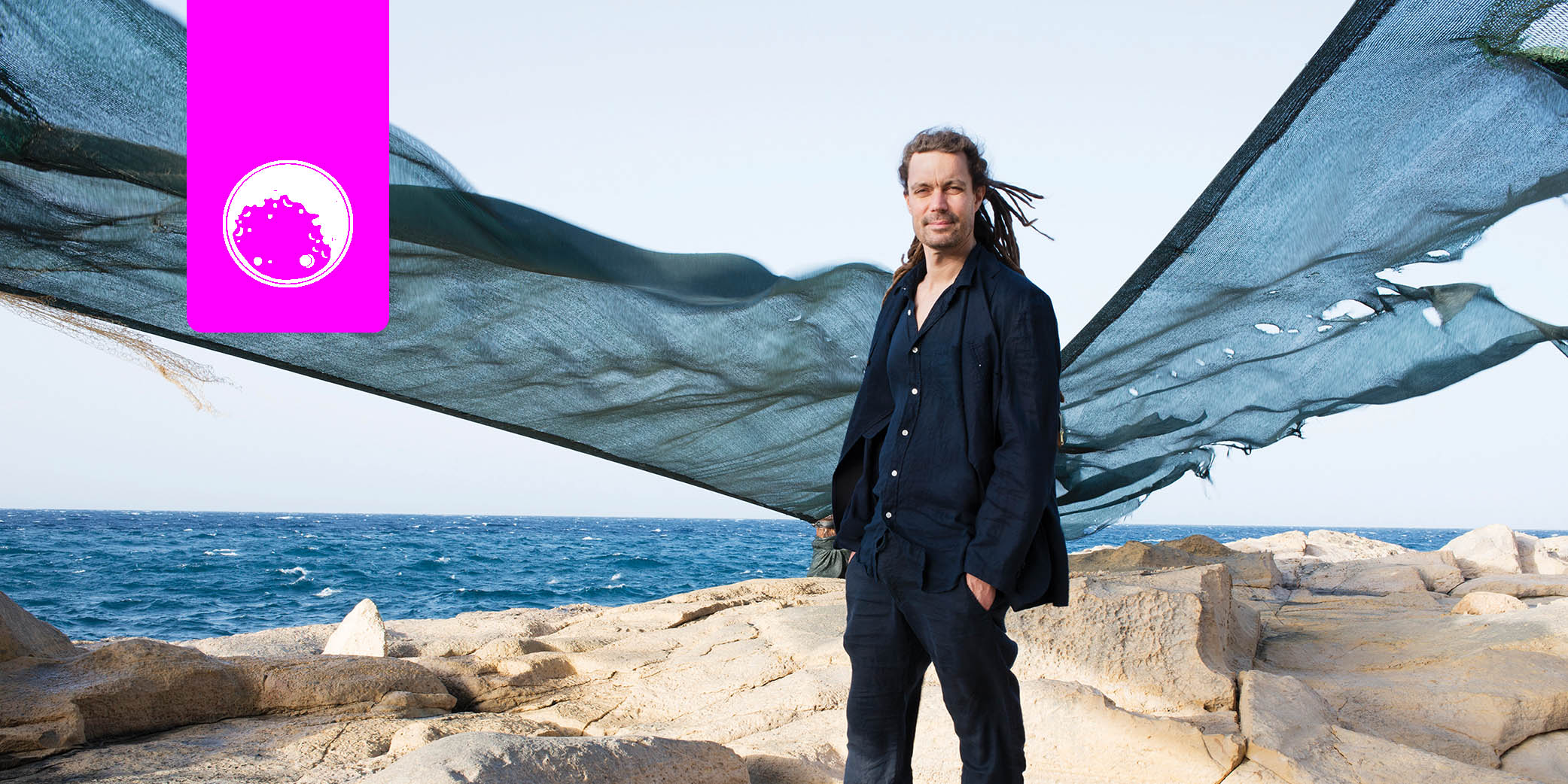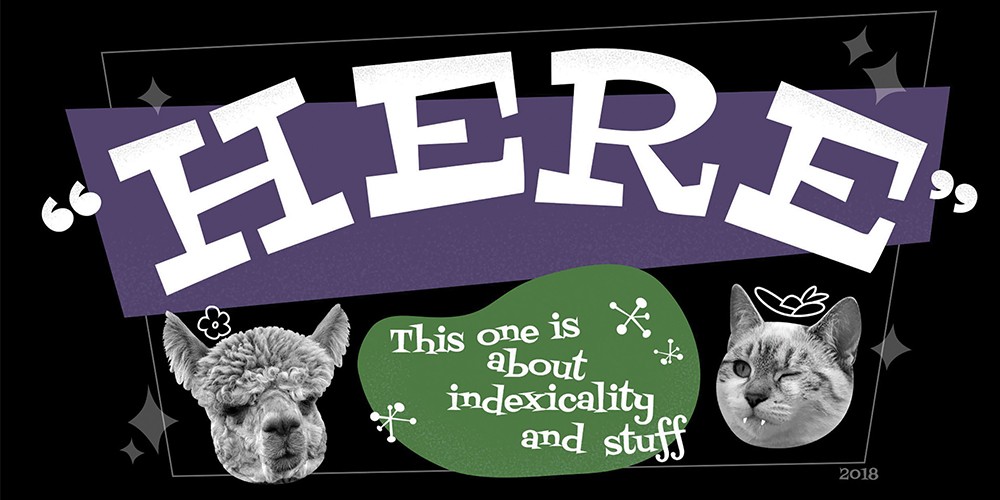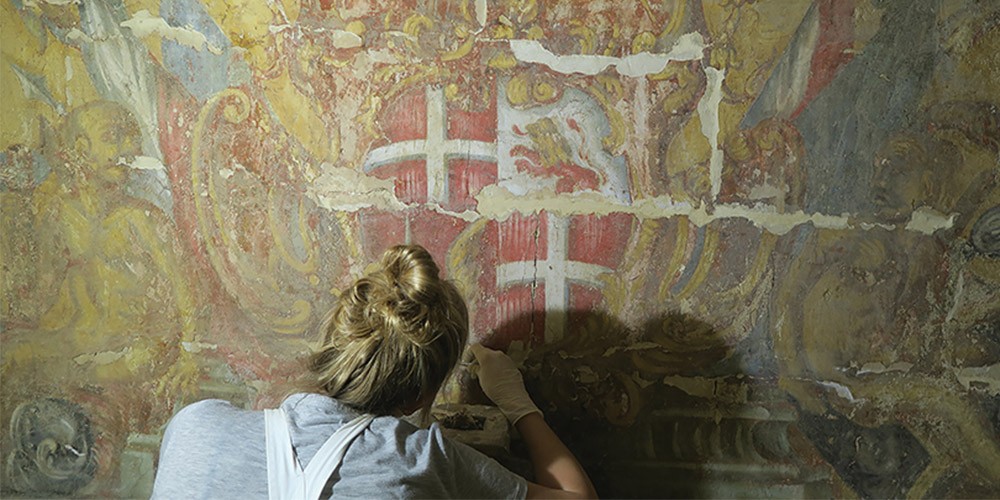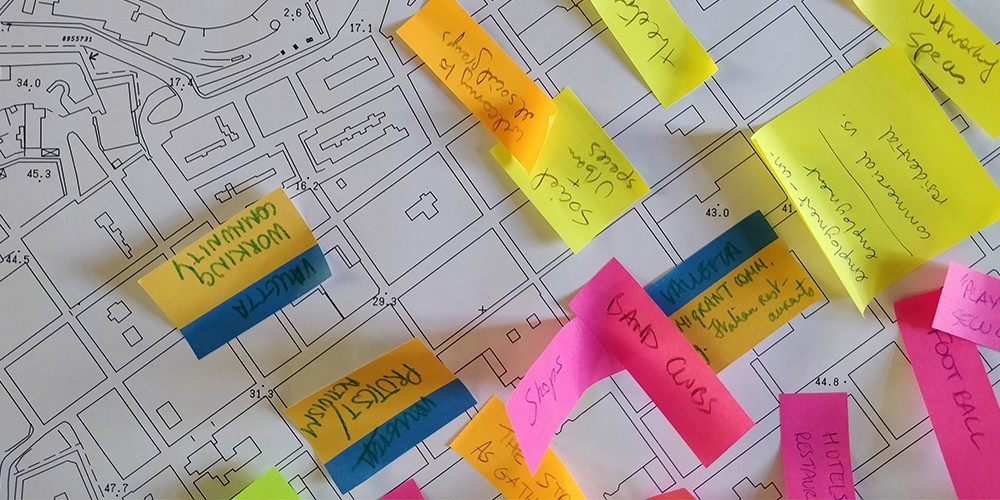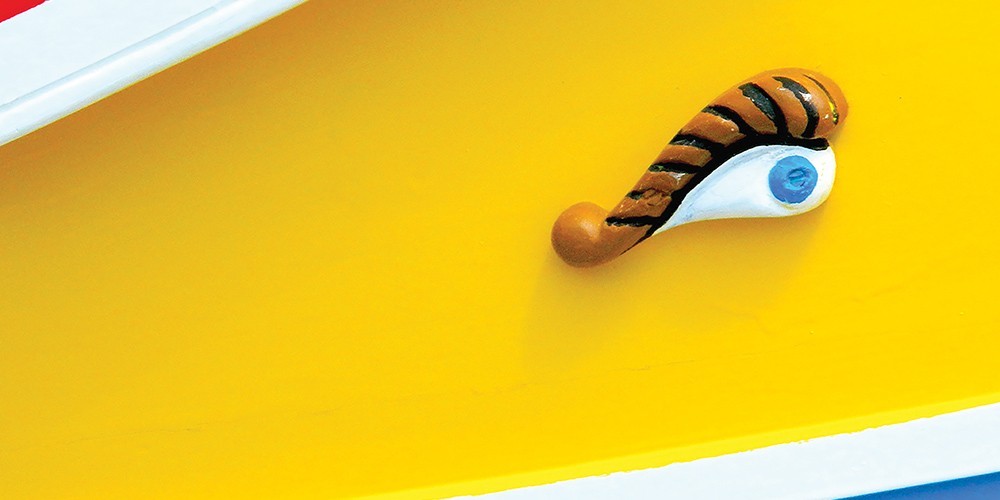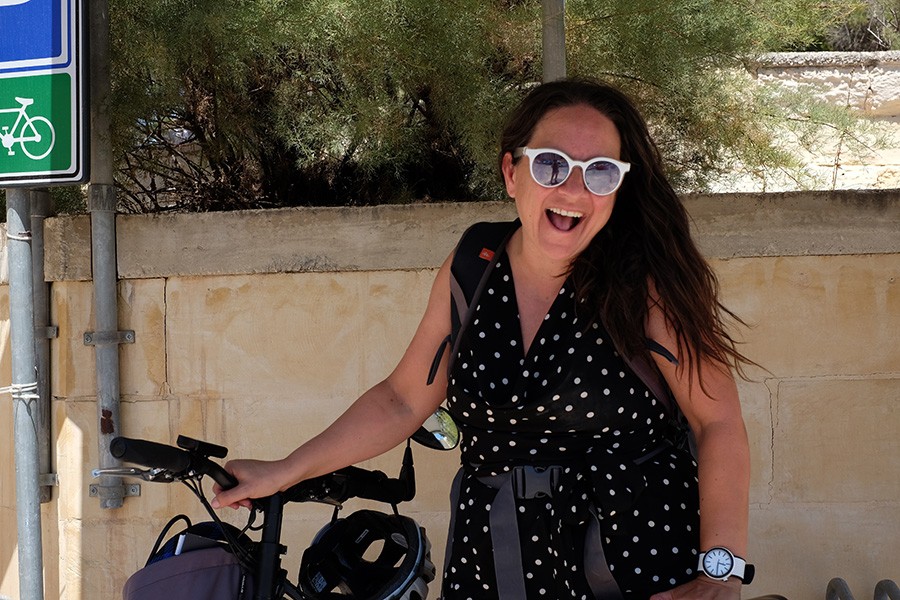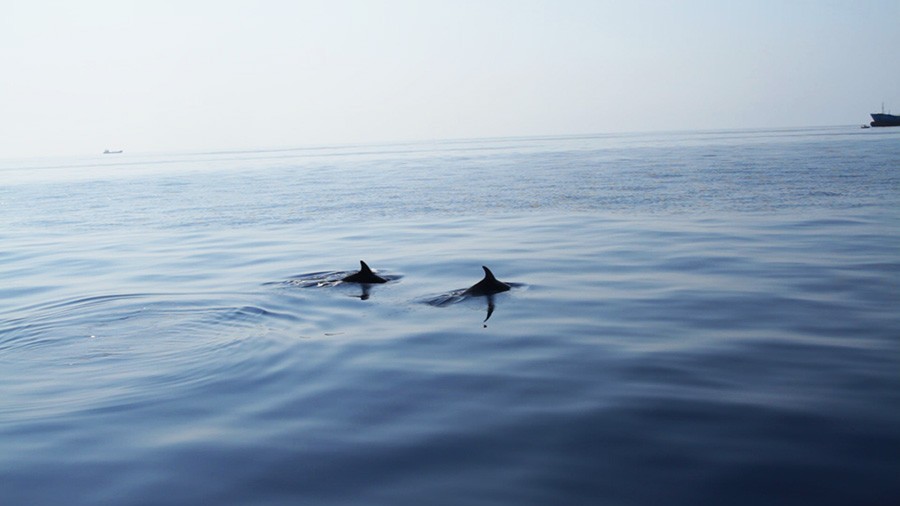Finding the soul in the machine
Swiss artist, documentary filmmaker, and researcher Dr Adnan Hadzi has recently made Malta his home and can currently be found lecturing in interactive art at the University of Malta. He speaks to Teodor Reljic about how the information technology zeitgeist is spewing up some alarming developments, arguing that art may be our most appropriate bulwark against the onslaught of privacy invasion and the unsavoury aspects of artificial intelligence.
Continue readingCome ‘Here’!
A pointed index finger can mean many things. It can direct our attention to something, show us which way to go, or demand silence. It all depends on context—the situation in which it is used. This is what philosophers refer to as ‘indexicality’. And yes, you guessed it, the word ‘indexicality’ comes from the name of that particular finger.
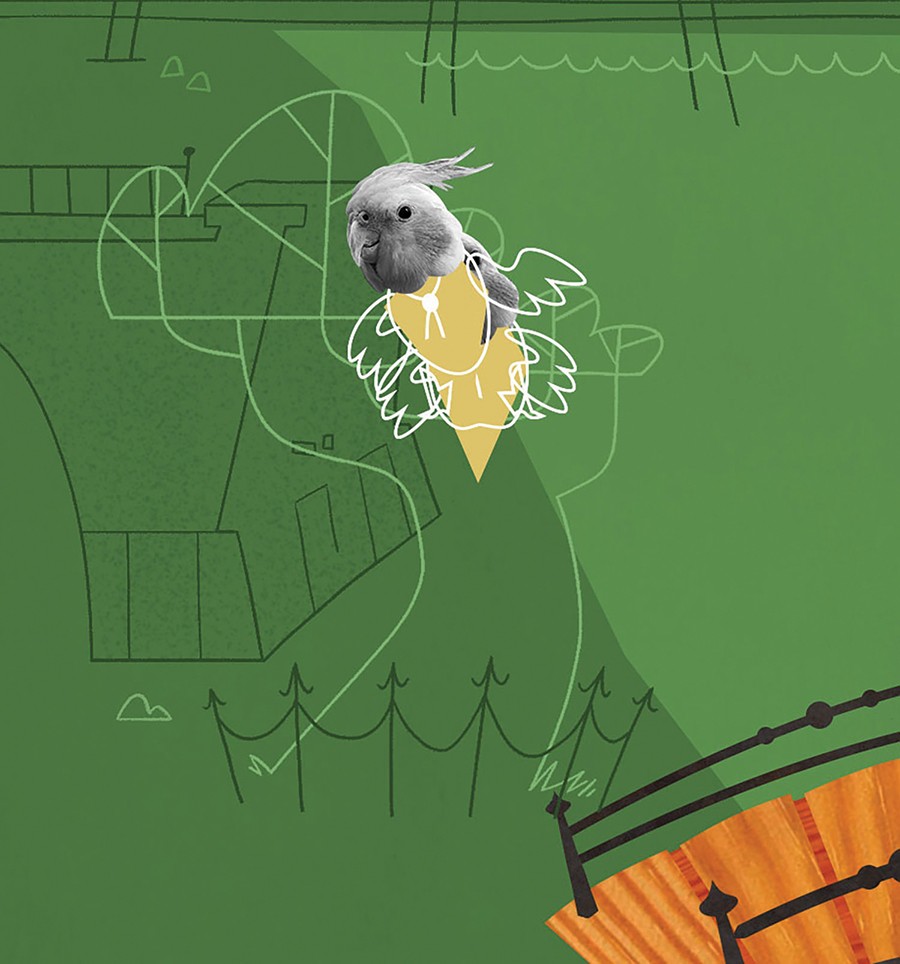
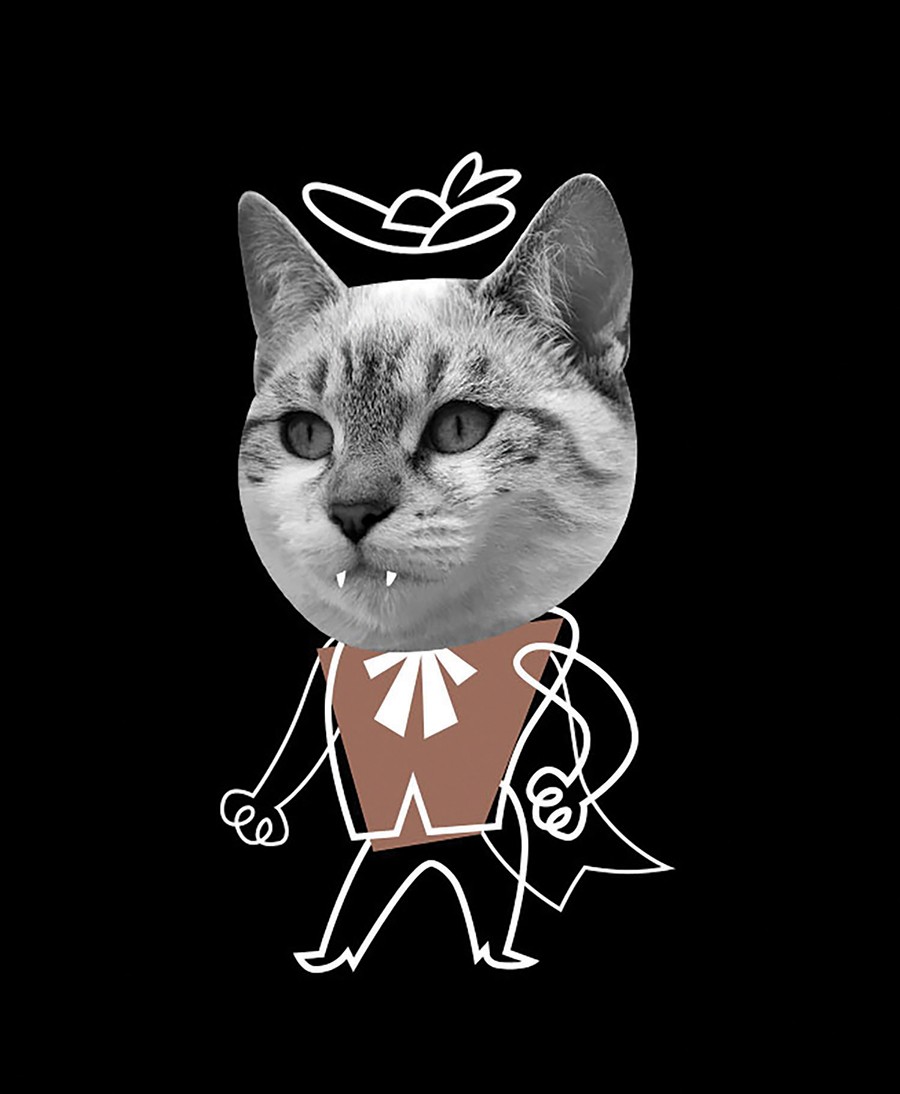
At the University of Malta’s Institute of Digital Games, Prof. Stefano Gualeni has been playing around with this concept. Featuring the voice acting talents of independent game developers Emily Short and Pippin Barr, Gualeni has created a video game called Here, designed for players to engage with (and get confused by) the concept of indexicality.
Here’s gameplay poses the question of what it means when we say ‘here’ in a game world, and how many meanings of ‘here’ can exist side-by-side in a video game. It uses the trope from Japanese Role Playing Games of going on quests to retrieve bizarre items from classic locations. Spooky caves and castles are all part of the repertoire of locations that players can explore. But then, where do you go if ‘here’ is your instruction? What if ‘here’ isn’t where you think it is? What if you’re supposed to go upside down instead?
To try the game yourself, visit www.here.gua-le-ni.com
Author: Cassi Camilleri
Conserving brushstrokes
A new conservation project will soon start work on one of Malta’s most significant historical artworks. Laura Bonnici meets Prof. JoAnn Cassar, Jennifer Porter, Dr Chiara Pasian, and Roberta De Angelis to find out why conserving the d’Aleccio Great Siege Wall Painting Cycle is of national importance.
Continue readingSmall islands, big research
Small island developing states are vulnerable and need unique solutions to overcome the hazards of climate change. Dr Stefano Moncada writes about research which tries to find the right answers to a complex problem.
Continue readingKidney Stakes
A small team of scientists at the University of Malta is trying to determine what causes children to be born with serious kidney defects. Laura Bonnici speaks to Prof. Alex Felice, Dr Valerie Said Conti, Esther Zammit, and Alan Curry to find out more about this ground-breaking programme.
‘I’d sell a kidney for that!’ Most of us have been guilty of using this expression when faced with something desirable. But do we fully appreciate the real value of what we are offering before the words escape our lips?
Kidneys are our body’s official waste disposal system, filtering out toxic build-up from our blood, which can poison us if left unchecked. With kidney failure posing such a threat, renal research has become an ongoing global goal.
A team of scientists from the University of Malta is currently honing in on what may cause children to be born with ‘CAKUT’, or Congenital Anomalies of the Kidney and Urinary Tract.
With between three and six cases recorded per 1000 live births worldwide, CAKUT is the most common cause of end-stage kidney disease in children. Since early identification of these anomalies may reduce kidney damage later in life, the LifeCycle Malta Foundation has raised funds for a renal research programme which targets CAKUT and its causes.
‘We know that a number of children are born with a kidney defect, but in many cases, we are not sure why,’ explains the programme’s principal investigator, Dr Valerie Said Conti . ‘There are many factors that can affect the development of the kidney, both genetic and environmental. We are trying to understand those influences so that we can carry out preventative strategies, diagnose issues earlier, and target personal therapeutic interventions.’
A number of children are born with a kidney defect, but in many cases, we are not sure why.
For this team of renal researchers, the first three years of initial research has been the first step in a far longer journey. ‘We hope to contribute our data to the international literature pool,’ continues Prof. Alex Felice, consultant and supervisor on the programme. ‘We will need a massive amount of data to create a robust theory with which to progress. We hope that our findings regarding CAKUT will be useful when we come to the stage of creating new interventions.’
It’s an end-game that has kept the small team focused as they approach the programme’s expected completion date this year. Having had to start literally from scratch, they collected biological samples from patients with a range of kidney diseases, including CAKUT, nephrotic syndrome, and Bartter syndrome. This allowed them to build the renal disease collection at the Malta BioBank, a vital storehouse for scientists.
‘For research projects like this, you see what material is available and you work with it,’ explains Said Conti . ‘A big part of it so far has been sourcing the samples from families attending the clinic with their formal consent for the material to be used in this project. We are hugely grateful to those who accepted to take part in the research. Without them, it would have been impossible.’
This project has set the groundwork for renal research in Malta to continue. ‘Without funding, projects such as this one simply could not exist,’ Said Conti remarks of the €100,000 donation LifeCycle Malta Foundation made to RIDT. ‘It enabled us to employ a full-ti me Research Support Officer, involve other laboratories, attend international meetings to share insights, perform ultrasound tests, and invest in ‘Next Generation DNA Sequencing’, genetic technology that maps out genes, revolutionising our world.’ But there is much more to come.
The Founder of the LifeCycle Malta Foundation, Personal Fitness Consultant Alan Curry, agrees. ‘Renal failure is an ever-increasing problem with figures going up every year, and LifeCycle is the only NGO that is actively supporting renal patients and their families in Malta. Our annual LifeCycle Challenge, which this year is routed from Dubai to Oman, aims to raise €150,000. It’s a huge responsibility, but we are sure that, by funding research programmes such as this, we will significantly improve the lives of kidney patients.’
Author: Laura Bonnici
Grassroot legacy
Capitals of Culture want legacy. Wrocław 2016 established a microgrant system for small operators that is still in place. Aarhus 2017 combined qualitative and quantitative methods to evaluate a city’s cultural sustainability. Valletta 2018 wants to leave behind a vibrant grassroots movement actively shaping the country’s cultural policy. Rachel Baldacchino speaks to Szilvia Nagy to find out how this is possible…
Continue readingLuzzu Truths
Strolling along Malta’s coast, you’ll be mesmerised by the rainbow of traditional fishing boats ambling on the water—that and all the eyes ogling at you from their bows. Katre Tatrik takes a closer look at the hidden meaning behind the luzzu’s colours.
The Maltese luzzu dates back to the time of the ancient Phoenicians. For generations, Maltese fishermen have painted them in a kaleidoscope of bright colours, turning them into a national icon. But is there rhyme or reason to the hues they choose? Lifelong fishermen, brothers Charles (62) and Carmelo (70) from Marsaxlokk, paint their luzzus twice a year in bold blues, reds, and yellows. It’s no easy task, requiring thorough cleaning and six layers of paint. Despite their dedication, Charles and Carmelo, like many others, are largely unaware of the hidden meanings the colours on their boats carry. ‘They’re all the same,’ Carmelo says. ‘It’s just for beauty.’ Charles adds that ‘these boats have always looked the way they look.’
But in 2016, Prof. Anthony Aquilina from the University of Malta embarked on a project that would uncover more. ‘Contrary to what you have been told, there is a lot of meaning in the way our traditional boats are painted,’ he explains. Aquilina edited and published The Boats of Malta – The Art of the Fisherman, written by world-famous anthropologist Desmond Morris.
Morris resided in Malta for six years in the 1970s, visiting each of the fishing villages on the islands. During his stay, he sketched some 400 of the 700 traditional boats anchored in the coastal villages. He wrote: ‘to visit a Maltese fishing village is like entering a huge, open-air art exhibition.’
Summing up Morris’ work, Aquilina says that ‘even in a small country, you can see the difference between one locality and another. But at the same time, there is the individual stamp of the fisherman, of that particular person.’
To visit a Maltese fishing village is like entering a huge, open-air art exhibition.
Morris’ main findings show that some traditional rules come into play when choosing the colour palette for a luzzu.
Whilst reddish brown or maroon was typically painted on the lower half of the boat to mark the waterline, the locality of a boat’s owner could be identified by the colour of its mustaċċ. The mustaċċ is the band above the lower half of the boat, shaped like a moustache, which gives the feature its name. A red mustaċċ would indicate that the boat came from St Paul’s Bay, for example. A lemon yellow indicated a boat from
Msida or St Julian’s, whilst an ochre yellow one would identify the boat as hailing from the Marsaxlokk and Marsascala area. When a mustaċċ was painted black, it denoted mourning for a death in the family.
In addition to colours, decorations also send a message. In more than half of luzzus, signature eyes are painted on the bow or the stern—symbols of protection for fishermen out at sea. Where the eyes are not seen, other symbols such as a rising sun, a Maltese cross, fish, shooting stars, or lions are painted on. The gangway, usually varnished brown, can be heavily decorated or engraved with symbols of the sea and the island: shells, mermaids, birds, flowers. Religious insignia are common too, with doves, olivebranches, and lambs often making an appearance.
Political or religious influences also come into play where a luzzu’s name is concerned. During the time we spent in Marsaxlokk, we saw San Mikiel (Saint Michael the Archangel, patron saint of Isla), John F. Kennedy, and Ben Hur.
Even if Charles and Carmelo couldn’t tell us what the luzzu’s colours mean, their dedication to tradition is undeniable. Before we left, they said they were fearful that this part of Malta’s heritage may fade away as featureless carbon-fibre boats wade in. I hope they’re wrong.
Author: Katre Tatrik
Cycling to University: motives and barriers
This time last year, I decided to start cycling to my office at the University of Malta. Though much of my work focuses on this kind of behavioural change, I would be lying if I said that I did it for environmental or research reasons. I did it out of sheer despair: I felt like I was wasting my life, stuck in traffic for hours on end. I will also readily admit that when I started, I was not adequately prepared: I was not fit enough for it. Nor did I have the agility and speed to compete with cars while balancing on two narrow wheels. But I somehow hung in there. And somehow, before I knew it, a whole year had gone and I had never used a car to come to university—nor ever wanted to.
One of the forces that made a real difference was ‘others’. While I’d long marveled at my friends and colleagues at universities overseas who cycled to work without much fanfare, it was finding a community of commuting cyclists here in Malta that really made a difference. Gathered as the ‘Bicycle Advocacy Group‘ on Facebook, they are a new cyclist’s best allies. They helped me find bike-friendly (and unfriendly) roads, plot routes ahead of time, and consoled me after bad incidents. They organise group rides. They advocate and educate. Groups on campus such as the Green Travel Plan people were also great. In the world of cycling, unlike that of driving, the more we are, the merrier it is!
The second major step in this journey was to make it increasingly easy for me to choose the bike over car. A car key always looks so easy to pick up. Instead, I prepared my bike, my bag, my helmet, and all my accessories by the door. I left some extra clothes and toiletries at work, ready when needed. I changed my days around to make them cycle friendly, clustering meetings, avoiding heavy loads. I also made it a point to reward myself for cycling by keeping snacks handy for energy. This probably explains why I did not lose any weight despite a whole year of pedaling.
While I’d long marveled at my friends and colleagues at universities overseas who cycled to work without much fanfare, it was finding a community of commuting cyclists here in Malta that really made a difference.
All this said, the main barrier for lots of people (and myself) is the fear of being hurt on the road. I learnt a few practical tricks that made cycling less scary. The first is that lowering risk is entirely possible. Some times are better than others for cycling. In peak traffic, cars are moving very slowly or at a complete standstill, making it somewhat safer for you to cycle! Some roads are also better than others. With time, I found out that it is possible to use country lanes or smaller urban roads for most journeys. Where traffic is unavoidable, I stick to the middle of the lane, especially if a driver cannot safely pass while leaving a meter of space. Traffic will wait behind you (often the speed limit is 30km/hr anyway). This is even more important if there’s a row of cars to your right where anyone can open a door and knock you off the bike. Thirdly, I learnt to signal large so drivers know my intent. I also learnt cycling is a mental and physical work out. You need to be completely focused and watch out for any possible danger. Where needed, I get off my bike and cross roads on foot.
While poor public infrastructure and law enforcement remain a constraint, I gradually bought things that made the cycling life easier. My first purchase was the bicycle. I started with a basic folding bike (€200 or so). I chose a folding bike to give myself a parachute in case I got too tired and needed a lift home. The climb to Gharghur from University was nothing short of exhausting. I walked most of it for the first few weeks. Then a very attractive grant was issued for e-bikes. This changed everything: you may pedal less on an e-bike but you will certainly cycle more frequently. Later, I stuck a rack and a basket to the bike. I bought a trekking backpack (which means I sweat less), a good water bottle (which also comes in handy to wash my hands), and a helmet (even though it’s not a legal obligation to wear one). I got a high visibility vest (free from several campaigns), white and red lights and reflectors (though I’m still rather scared to cycle at night), and a mirror, which helps me see cars coming from the rear without having to turn my head and risk losing my balance. I’m still angling for a good bell, better fenders, and flat tyre-changing supplies. I eventually bought a good lock—a must.
Like other positive habits, the more you do it, the more you love it. I especially love not having to look for parking, getting to places quickly and on time, and discovering new routes. I love smiling at people, feeling younger and fitter. In hindsight, and with a rather limited sample size of one, I can see that what made it work (consciously or not) was quite in line with research: a break in habit, a combination of lower barriers, and stronger motives.
Author: Dr Marie Briguglio
Chasing the white whale: the pursuit of sustainable tourism in Malta
EcoMarine Malta’s boat tours are leading the way in environmentally sustainable tourism around the Maltese Islands. Founder Patrizia Patti talks to Edward Thomas about how economic success doesn’t need to be sacrificed in order to protect nature.
Aquarter of Malta’s GDP comes from the tourism industry. It accounts for €2 billion annually and shows no sign of slowing down. Tourist expenditure went up by 13.9% from 2016 to 2017 alone. It constitutes one in every seven jobs in the local economy and maintains a close link to development: better hotels, improved roads, more diverse shops and restaurants. Beyond the economic benefits, tourism promotes and celebrates local customs, food, traditions, and festivals, creating a sense of civic pride.
However, there are concerns. In July and August, Malta, Gozo, and Comino are covered by thousands of holiday-makers flocking in. This is a not only a burden on already strained island resources and infrastructure including water, waste management, and traffic congestion, but it pushes many coastal habitats and aquatic ecosystems to the breaking point, with drastic impacts on local biodiversity.
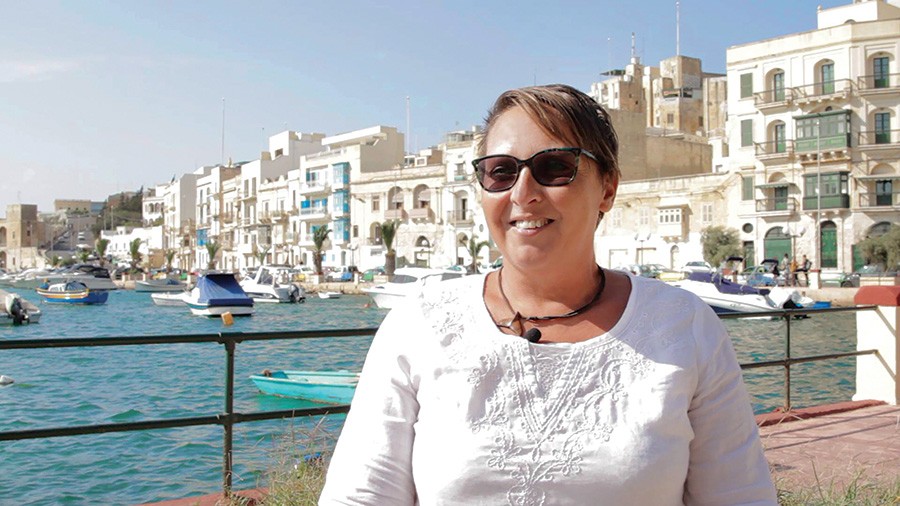
Marine biologist Patrizia Patti laments how ‘people go with speed boats to Comino carrying beers, drinking, throwing bottles into the sea, playing loud music… it disturbs everything.’ If larger tour companies made a small effort to be more responsible, it could have a large effect, she says. ‘Even a simple announcement on a microphone, reminding people they are in a protected area and to behave in a certain way, advising people to respect nature, would help. It’s only a small reminder but it would help a lot.’ Always looking to lead by example, and to show that small actions can have a great impact, Patti set up EcoMarine Malta. The start up organises responsible boat tours around the island, where the international code of conduct is followed and people can experience the joy of encountering dolphins, turtles, and seabirds in their natural habitat.
FACE TO FACE
Patti says their goal is to establish profound personal connections between people and the sea in the hopes that it will change behaviour. She has been passionate about marine biology since the age of 17, when she first encountered a dolphin. That happened during a school trip to an aquarium. She says ‘it was exciting because it was the first time I saw a dolphin, but it was terrible seeing it trapped in a small tank. It made me so sad.’ The emotional response was strong enough to move Patti to tears. ‘It was at that point I decided I wanted to become a marine biologist. I wanted to help.’
Patti went on to study the ecology of sperm whales in the Ligurian Sea before travelling far and wide, gaining experience working with marine mammals in Canada, the Maldives, and the Red Sea. In 2013, she cofounded Costa Balenae Whale and Nature Watching in Italy, a company, like Eco Marine Malta, which strongly focuses on bringing humans closer to marine wildlife, forming lasting memories that inspire them to consider their environmental impact and educating both children and adults about the natural biodiversity of the Mediterranean Sea.
How can you love something and want to protect it when you’ve never seen it?
Seeing these animals and experiencing their natural environment first hand is vital to establishing an emotional bond. This is what then engages people and inspires them to change their behaviour. ‘How can you love something and want to protect it when you’ve never seen it?’ Patti questions. By opening local and tourists’ eyes to the majesty of indigenous species, EcoMarine Malta create compassion and motivate people to take responsibility for the environment too. They also chip away at the sense of helplessness many feel when it comes to ‘actually making a difference.’ EcoMarine Malta provide education and information for their passengers to follow. Patti, who leads the tours herself, goes into how they can enjoy Malta’s beaches responsibly and sustainably, empowering them to take ownership for their actions and decisions before it’s too late.
MONEY PROBLEMS
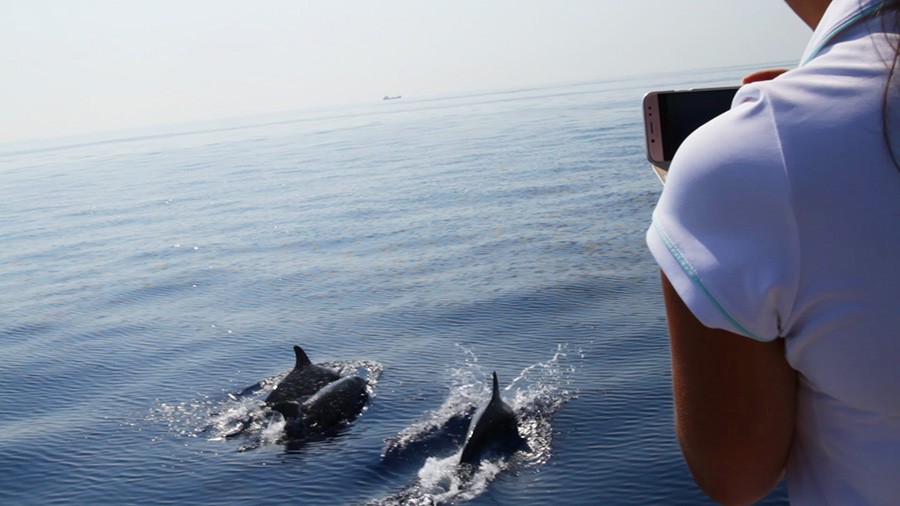
It’s not always been plain sailing for EcoMarine Malta and their boat trips. Patti firmly believes that environmental conservation can be a tool to increase economic growth and employment in Malta. ‘Even if we act like an NGO, we decided to be a private company
because we want to create job places and grow and be able to provide the best service possible,’ Patti says. But not everyone agrees. Patti has received plenty of push back from others in the field as she lobbies for best practices to be enforced around the islands.
Some views are severely narrow and short-sighted, rooted in the belief that any sort of restriction of operations is bad, even if inspired by respect and protection for the natural resources they use. ‘People have to understand that a protected area is to enjoy for a long time. Maybe not now, maybe for one or two years you have to be careful, you can’t do everything you want to do. But after those two years, you can enjoy a new beautiful area, rich in life,’ explains Patti. Setting up EcoMarine Malta as a for-profit enterprise to prove these people wrong, however, has led to another kettle of fish. Because they’re not an NGO, applying for sponsorship and funding is a major challenge. Potential benefactors often dismiss collaboration, telling Patti that the company should be able to support its own endeavours.
This lack of support saw EcoMarine Malta having to rent boats from various charter companies, a massive expense. Externally renting a boat brought with it uncertainty and inflexibility. Last-minute dropouts or weather changes forced them to cancel tours and lose a lot of money. ‘The boat rental still had to paid for,’ she says. But things are looking up. EcoMarine Malta purchased their own boat this summer, and Patti is working hard on getting all the permits in place to have it out on the water as soon as possible. ‘Now we will be able to plan our own routes and diversify the tours we offer. At the moment, we have six tours available to choose from, including a sunset tour when marine life is at its most active,’ she smiles.
GET THEM YOUNG
2018 might be EcoMarine Malta’s first full summer season, but that doesn’t stop Patti from dreaming big about their future. She and her team want to do more outreach and education and are working on offering a series of courses for students aged between 10 and 16 years old. These children will be able to participate in a day of hands-on classroom activities, discovering and learning about sustainability and the ecosystem of the Mediterranean, followed by a boat trip to implement their new knowledge, observing and identifying the variety of wildlife and nature surrounding them and their island. ‘We hope to inspire a whole new generation of marine biologists and environmental scientists,’ Patti says.
With an army of environmentalists in the making, Patti hopes they will take over her role in the future. That would allow her to refocus on a passion she is itching to pick up again: searching for evidence of sperm whales in the Mediterranean surrounding the Maltese Islands. Her eyes light up as she admits to me, ‘I love outreach, but my personal dream is to spot sperm whales in Malta.’ Researchers know that juvenile and female sperm whales in the Atlantic remain in warm waters while the males migrate to the poles to feed, but movements and social dynamics of pods in the Mediterranean are still unclear.
With an army of environmentalists in the making, Patti hopes they will take over her role in the future.
Looking forward, Patti is working hard to establish networks with other entities and NGOs who share the same vision. EcoMarine Malta already collaborates with the likes of Birdlife Malta and has been involved with beach ‘Clean Up’ projects in the past year. Patti asserts that despite everything, ‘the Maltese public and tourists are some of the most enthusiastic and passionate people we’ve worked with so far. It’s great to see people of all ages and backgrounds, coming together to work on a common goal.’
‘Everyone can contribute different things, and together, it adds up to make a big difference.’ Patti is keen to encourage people to help in whatever way they can. To cooperate with others and not feel overwhelmed or alone in their efforts. ‘It’s not possible to do it alone. We need to work together, holistically, caring about the land, sea, and air, to protect the island’s environment.

